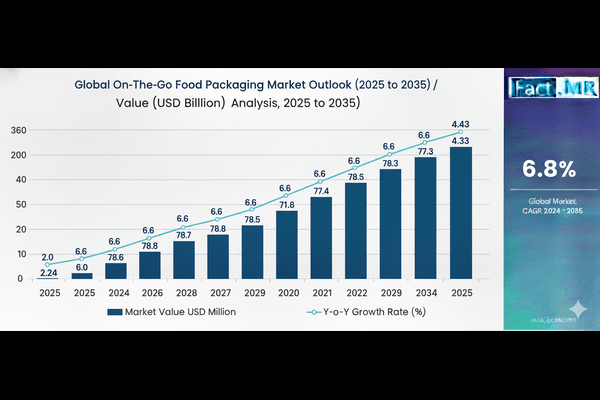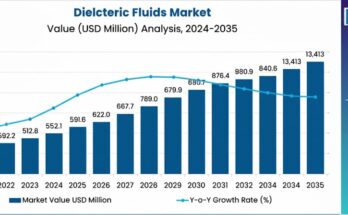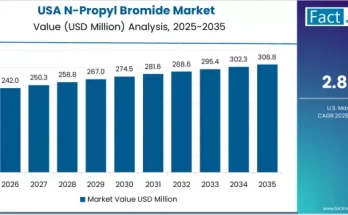The global on-the-go food packaging market is poised for robust growth over the next decade, propelled by rising urbanization, evolving consumer lifestyles, and heightened demand for sustainable, convenient packaging solutions. According to Fact.MR, the market is estimated at USD 2.24 billion in 2025 and is projected to reach USD 4.33 billion by 2035, expanding at a compound annual growth rate (CAGR) of 6.8%.
The Fact.MR report, “On-the-Go Food Packaging Market Outlook 2025–2035,” reveals that growth will be driven by the proliferation of single-serve, portable food formats and the adoption of eco-friendly materials. Urban millennials, working professionals, and a growing e-commerce ecosystem are transforming demand patterns, emphasizing convenience, hygiene, and sustainability.
Rising Urbanization and Lifestyle Changes Fuel Demand
Rapid urbanization and the increasingly hectic pace of city life are key factors driving the adoption of on-the-go packaging. Consumers across metropolitan areas are seeking ready-to-eat, portable food options, prompting manufacturers to enhance packaging mobility, durability, and shelf-life. Bakery and confectionery products are emerging as the most lucrative segments, driven by snacking trends, portion control preferences, and visually appealing packaging, with a projected CAGR of 7.9% between 2025 and 2035.
Sustainability and Regulatory Dynamics
Sustainability is a critical driver and challenge for the sector. Regulatory pressures in North America, Europe, and Asia Pacific are pushing manufacturers toward recyclable, biodegradable, and compostable packaging. Fact.MR highlights that while green materials raise production costs, they also offer differentiation in a market increasingly oriented toward environmental responsibility. PET (polyethylene terephthalate) is anticipated to be the most profitable material segment, with a CAGR of 7.4%, due to its transparency, recyclability, and compatibility with most food products.
Technological Innovations Driving Market Differentiation
Advanced packaging technologies such as antimicrobial films, oxygen scavengers, freshness indicators, and smart thermoforming solutions are redefining product safety, shelf-life, and consumer appeal. Injection moulding, in particular, is expected to experience the fastest growth (CAGR 7.5%), enabling complex, customized, and premium food packaging solutions. Flexible formats like pouches and sachets are projected to dominate revenue growth, with a CAGR of 8.1%, due to affordability, versatility, and suitability for on-the-go consumption.
Regional Market Insights
-
United States: Forecasted to grow at a CAGR of 4.0%, driven by technological innovation, convenience-driven consumer habits, and strong regulatory frameworks.
-
India: Positioned for rapid growth at a CAGR of 7.3%, propelled by urbanization, rising disposable incomes, e-commerce penetration, and evolving food consumption patterns.
-
China: Expected to grow steadily at 6.0% CAGR, supported by urban middle-class consumers seeking convenience foods, along with regulatory focus on sustainability.
-
Europe: The UK, Germany, France, and Italy are expected to witness steady growth (3.9–4.5% CAGR) as eco-friendly materials and regulatory compliance become pivotal.
-
Asia Pacific & South Korea/Japan: Expansion driven by high-tech adoption, urban lifestyles, and rising preference for sustainable packaging solutions.
Competitive Landscape
Leading players shaping the on-the-go food packaging market include:
-
Amcor Limited (25–30% market share) – Strong focus on eco-friendly solutions and innovation in North America and Europe.
-
Mondi Group (20–25%) – Emphasis on recyclable, biodegradable packaging and global expansion.
-
Sonoco Products Company (15–20%) – Diverse portfolio and sustainability-driven initiatives.
-
Bemis Company Inc. (10–15%) – Advanced flexible packaging solutions.
-
Smurfit Kappa Group PLC (8–12%) – E-commerce and sustainable corrugated packaging growth.
-
Huhtamäki Oyj & Sealed Air Corporation (5–10%) – Compostable and protective packaging solutions.
These industry leaders are driving growth by investing in material innovation, automation, digitalization, and regulatory compliance while forming strategic alliances to scale operations globally.
Key Growth Drivers
-
Convenience & Portability – Growing demand for single-serve, grab-and-go food formats.
-
Sustainability Push – Regulatory mandates and consumer preference driving eco-friendly material adoption.
-
Technological Advancements – Smart and high-barrier packaging enhancing product safety and shelf-life.
-
E-commerce & Digital Sales – Online retail expansion enabling wider distribution and consumer access.
-
Urbanization & Rising Disposable Income – Shaping consumption patterns toward premium, ready-to-eat foods.
Challenges & Market Constraints
The sector faces constraints such as raw material price volatility, fragmented recycling networks, high production costs for sustainable materials, and regulatory compliance. Fact.MR emphasizes that manufacturers capable of balancing cost, innovation, and regulatory adherence will capture premium market segments and long-term growth opportunities.
Browse Full Report : https://www.factmr.com/report/476/on-the-go-food-packaging-market
Market Outlook: Next Decade of Expansion
From 2025 to 2035, the on-the-go food packaging industry is set to transform into a sustainability-led, technology-driven market. Flexible PET packaging, pouches & sachets, and injection moulding technologies will continue to dominate, while intelligent and smart packaging solutions will redefine consumer expectations for freshness, safety, and usability.
“Manufacturers who integrate sustainability, innovation, and regulatory foresight into their packaging strategies will emerge as market leaders,” said a Fact.MR analyst. “The market is evolving beyond packaging—it’s about enhancing the convenience, safety, and sustainability of the modern food experience.”



